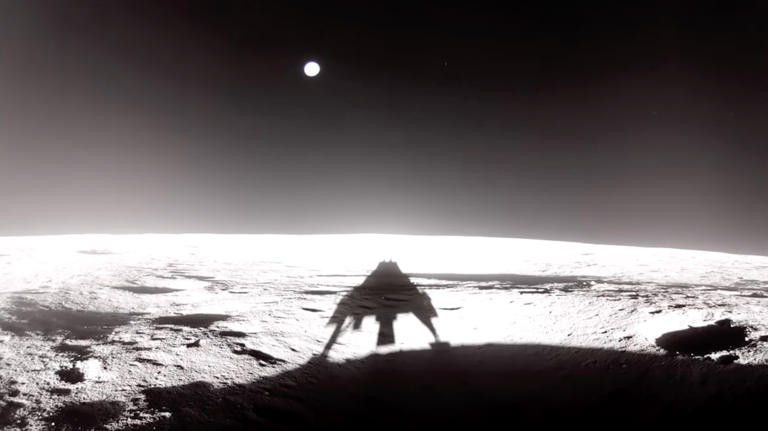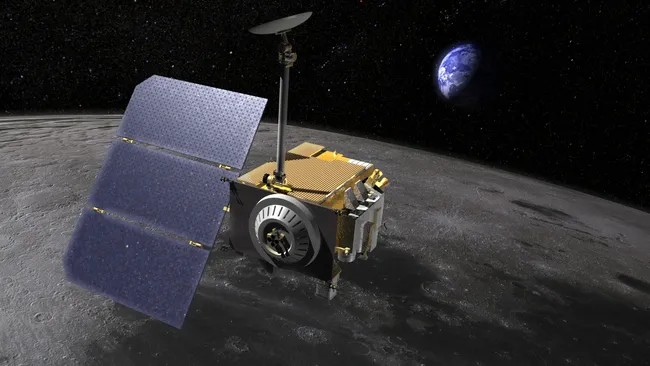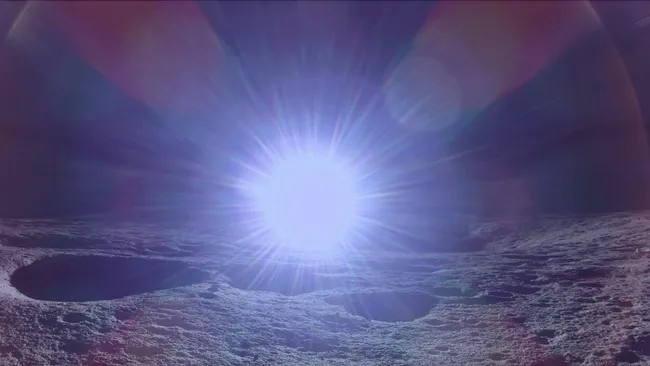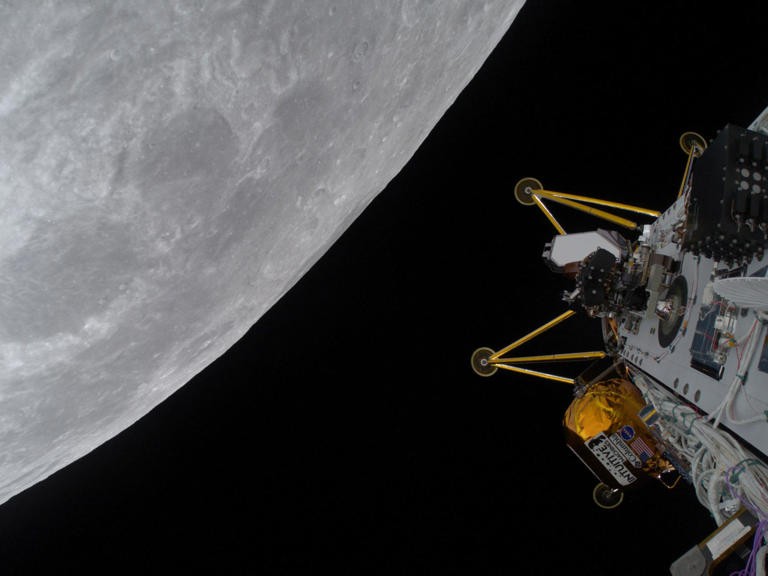Study
Research
Main Index
Space Cosmology
Science Research
*
About
Science Research
Science Theories
Desk
Site Map
BookShelf
Lunar Landers
Designed by Nigel G Wilcox
Pages within this section: Introduction
Pages within this section:
Lunar Lander on Moon
Powered By AM3L1A
Copyright © by Nigel G Wilcox · All Rights reserved · E-Mail: ngwilcox100@gmail.com
Sub-Menu
1
M
menu
2
3
4
5
6
8
SM
Lunar Landers
Private Blue Ghost lander spotted on the moon by NASA lunar orbiter
NASA's Lunar Reconnaissance Orbiter captured an exciting view of Firefly Aerospace's Blue Ghost lander following its recent touchdown on the moon.
Blue Ghost successfully landed on the moon on Sunday (March 2), touching down in Mare Crisium ("Sea of Crises") — a large impact basin about 345 miles (555 kilometers) wide. The spacecraft sits near a volcanic cone called Mons Latreille within the basin, which is located in the northeast region of the moon's near side.
The Lunar Reconnaissance Orbiter (LRO) spotted the lander among the moon's cratered surface in photos taken using the spacecraft's Narrow Angle Cameras. The photos, which NASA shared March 5 in a post on X (formally Twitter), were taken when the orbiter was roughly 109 miles (175 km) east of the Blue Ghost landing site.
Blue Ghost is a robotic lunar lander built and operated by the Texas-based company Firefly Aerospace. The lander flew to the moon as part of NASA's Commercial Lunar Payload Services (CLPS) program, which contracts private landers to deliver science and technology instruments to the lunar surface in support of the agency's Artemis program. Blue Ghost carried 10 such demonstration instruments with it to the moon.
The photos taken by LRO, which has been surveying the moon since 2009, show the Blue Ghost lander as a single bright pixel casting a shadow over the volcanic terrain. Since the images were taken from lunar orbit, it's hard to spot the little lander.
However, the base of Mons Latreille can be seen in the lower left corner of the image and used as a guide to find Blue Ghost, which landed within 330 feet (100 meters) of the volcanic feature.

Firefly Aerospace's Blue Ghost lunar lander captured this shot of its own shadow on the moon just after its touchdown on March 2, 2025. (Image credit: Firefly Aerospace)
The spacecraft is already hard at work, deploying its payloads, sampling lunar soil (or regolith) and taking photos of its surroundings. It will spend one lunar day, or about two Earth weeks, studying the moon and conducting technology demonstrations before the sun sets over Mare Crisium on March 16 and the solar-powered lander shuts down.
If all goes according to plan, the data obtained by Blue Ghost will provide insight to help prepare for future crewed Artemis missions and a more sustained human presence on the moon.
The touchdown action began today around 2:30 a.m. EST (0730 GMT), when Blue Ghost fired its engines in a "descent orbit insertion burn." The maneuver put the car-sized lander, which had been circling the moon from about 62 miles (100 kilometers) up, on course for the lunar surface.
The lander coasted for about 50 minutes, then began firing its thrusters again to reduce its orbital velocity and position itself above its targeted landing site — an area within Mare Crisium ("Sea of Crises"), a volcanic basin on the moon's near side.
Nine minutes later, Blue Ghost shut off its main engine, entering the "terminal guidance" phase of the touchdown process. The lander continued to fire its small reaction control system thrusters to fine-tune its descent, heading for a relatively flat, boulder-free stretch of lunar ground that Blue Ghost autonomously selected as a safe landing spot.
"Every single thing was clockwork, even when we landed," Firefly CEO Jason Kim said during the landing webcast. "We've got some moon dust on our boots!"
The first-ever private moon landing occurred just over a year ago; Intuitive Machines' Odysseus spacecraft pulled off the feat in February 2024.

The Lunar Reconnaissance Orbiter (LRO) is an uncrewed spacecraft currently orbiting and studying the moon (Image credit: NASA/GSFC)
NASA's Lunar Reconnaissance Orbiter (LRO) has studied the moon up close since its launch in 2009 and continues to do so to this day.
When LRO launched, its mission planners intended the mission to last two years, with a primary goal of producing a 3D map of the moon's surface, according to NASA. Instead, LRO has lasted well over a decade — and its lifespan is far from over.
The mission particularly focuses on the moon's poles to search for water or ice thought to exist there.
Perhaps LRO's most well-known instrument is the Lunar Reconnaissance Orbiter Camera (LROC). This instrument consists of three cameras: two Narrow Angle Cameras, which provide 1,640-ft (500-meter) resolution n images over a 3-mile (5-km) wide area; and one Wide Angle Camera, which provide 328-ft (100-m) resolution images over a 37-mile (60-km) wide area.
Not long after LRO arrived at the moon, LROC captured the landing sites of several Apollo missions. The instrument's camera viewed the remaining lunar modules, astronauts' footprints through the moondust, and even scientific instruments that the astronauts left behind. The Apollo landing sites can further be explored on LROC's official website.
LROC has imaged other spacecraft, too: for instance, the Chang'e 3 and its Yutu rover, which landed on and traversed the lunar surface, respectively, in 2013; and the Vikram lander, which lost contact with its parent Chandrayaan 2 orbiter and crashed into the lunar surface in 2019.

Sunrise on the moon, as seen by Firefly Aerospace's Blue Ghost lunar lander. Firefly posted this photo on X on March 3, 2025. (Image credit: Firefly Aerospace)
Firefly Aerospace's Blue Ghost lander has captured a gorgeous shot of sunrise on the moon as it begins its workday on the lunar surface.
Blue Ghost aced its lunar landing attempt on Sunday (March 2), setting down close to Mons Latreille, a solitary lunar peak in the vast basin Mare Crisium ("Sea of Crises") in the northeastern region of the moon's near side.
And the spacecraft is already getting to work, starting up its science payloads and capturing amazing images of its surroundings and the distant Earth from the lunar surface.
'The latest image, posted by Firefly on the social media platform X on Monday (March 3), shows a dramatic sunrise, with the intensely bright sun contrasting with shadowed craters on an uneven lunar surface.
Firefly added that many of the 10 NASA science payloads aboard the lander have begun operating and will continue operations for the next two weeks and into the lunar night, when the solar-powered mission is set to conclude. The instruments will contribute to studies in a range of areas, including lunar composition, geology and heat flow on the moon and space weather. Blue Ghost will also test drilling technology, and its camera aims to capture how lunar dust levitates on the surface at sunset.

© Photograph: Intuitive Machines/AFP via Getty Images
The IM-2 mission Nova-C class lunar lander, Athena, in circular orbit around the Moon on 3 March 2025. Photograph: Intuitive Machines/AFP via Getty Images












